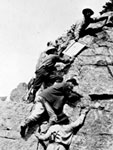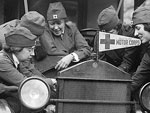The Museum of Broadcast Communications
The Museum of Broadcast Communications is dedicated to collecting, preserving, and making accessible historical and contemporary radio and television content, as well as artifacts and images documenting the history of broadcasting. To that end, it has amassed a collection of more than 25,000 television programs, 5,000 radio programs, and 12,000 commercials totaling close to 100,000 hours, as well as 1,800 objects and artifacts and 3,500 images from broadcasting history—all of which is available at its Chicago, IL location.
This website presents the more than 7,000 programs and commercials that have been digitized, as well as the entire collection of images, and selected artifacts. These materials include radio programs dating to the 1920s and television programming from the 1940s to the present. All materials are keyword searchable and browseable by select categories.
Those interested in the history of advertising, for example, can browse commercials by 23 categories, including automotive, alcoholic drinks, cosmetics, and leisure and hobbies. Radio and TV can both be browsed by program type, such as adventure, drama, dance, soap opera, and news. Images include headshots, publicity photos, scenes from the sets of television programs, and much more. Users must complete a simple registration process before searching the collections.
Teaching the Transcontinental Railroad

Do you have special materials to teach about the transcontinental railroad and its affects on the West? Specifically looking at those who were part of the labor force building the railroad.
There are several resources available for teaching about the transcontinental railroad. As always, we recommend using the search function on bottom right of our history content page. Here are a few resources that may be of some use.
The Central Pacific Railroad History Museum's site offers a detailed history and several primary sources regarding the construction of the transcontinental railroad, including, for example, photographs, legislation, and letters. They also have an extensive bibliography of print resources.
The Library of Congress’s American Memory Collection on the Chinese and westward expansion has several primary resources that document the experiences of Chinese laborers during the construction of the transcontinental railroad.
If you are looking to provide your students with a brief overview of the transcontinental railroad check out Digital History’s online textbook.
The virtual Museum of the City of San Francisco provides a brief but informative overview of the leading figures, like Leland Stanford, responsible for the completion of the transcontinental railroad.
Lastly, PBS has a lesson plan that examines two of the landmark documents regarding westward expansion: the Homestead Act and the Pacific Railway Act. Activity three in the lesson asks students to compare the construction of the transcontinental railroad from a variety of perspectives, including those of Chinese laborers. We should note that this lesson draws on a PBS documentary video that is not directly available on the site; but many resources are available on the site, and the activities can be easily adapted .
The Deadly Virus: The Influenza Epidemic of 1918

In 1918, an influenza epidemic swept around the world, killing an estimated 50 million people—34 million more than died in World War I—and attacking more than one-fifth of the world's population. No part of the United States was spared, as people in both urban and rural areas, from densely populated cities on the East Coast to those living in the Alaskan wilderness experienced the disease. This website offers 16 documents and images documenting this crisis. These sources reveal that many aspects of daily life in the United States were affected by the epidemic. Visitors can see, for example, a photograph of a mail carrier in New York City wearing a protective mask, telegrams from Arizona and Oklahoma describing the cancellation of public meetings and the symptoms of patients, and the personal letter of a nurse to her friend describing conditions at various military bases. Visitors can also order reproductions of these documents.